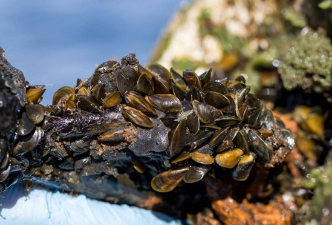



Source: California Department of Water Resources Copyright: (CC BY-NC 3.0)
Golden mussel (Limnoperna fortunei) is a bivalve mussel ranging in color from dark brown to gold in coloration. The inside of the shell can range from an iridescent mother-of-pearl coloration to purple. It can reach up to 1 ¾ inches long. Adults are able to attach to soft and hard substrates with byssal threads, creating dense blankets of mussels. Shell halves are very thin and brittle, and there are no hinge teeth.
Golden mussels are highly efficient filter-feeders that form dense colonies and consume large quantities of aquatic microscopic plants and animals that native species and sport fish depend on for food. Limnoperna fortunei filters water much faster than the highly-invasive Zebra Mussels, increasing water transparency, decreasing suspended matter (turbidity), chlorophyll a, and primary producers (phyto & zooplankton). Their dense colonies impede water flow, clog pipes, fouls watercraft motors, and require ongoing removal to maintain operational function of power plants and other facilities. This species negatively affects burrowing invertebrates and unionids in South America and may do the same in the Great Lakes given its high densities. Furthermore, large populations of Golden mussels promote the growth of harmful cyanobacteria (Microcystis spp. cells) in their colonies and favor blooms of these often-noxious Microcystis species.
Limnoperna fortunei requires external fertilization to reproduce and is considered a dioecious spawner with an equal ratio of males to females; however, Golden mussels can spawn continually in suitable conditions, as opposed to batch spawning that is observed in similar species (i.e. zebra mussel). Golden mussel adults can produce thousands of planktonic offspring (veligers), with estimates of 63 juveniles per square-meter to be recruited (established) annually. One adult mussel can process around 1 liter of water every 10 hours, eating organic particles like phytoplankton and zooplankton, and rejecting unwanted materials in mucus-like strands that settle on the bottom.
The first North American detection of golden mussel (Limnoperna fortunei) was in October 2024 in the Sacramento – San Joaquin Delta and O’Neill Forebay (Merced County). Introduction of the species into Japan and South America, is much like Zebra Mussels, through ballast water contaminated with veliger (larval) mussels. Like dreissenid mussels, this species has microscopic, planktonic larvae that are difficult to detect and can be transported in water accidentally.
Native Origin:Southeast Asia: China, Thailand, Korea, Laos, Vietnam, Indonesia, and Cambodia
Habitat: The golden mussel (Limnoperna fortunei) can establish in waters with wider temperature and salinity ranges, inhabiting fresh and brackish-water lakes, rivers, creeks, wetlands, bays, and canals; with a wider range of temperature (41-95°F) and salinity tolerance compared to invasive Dreissena mussels (Zebra and Quagga) with water temperatures ranging from. Golden mussels can attach to all sorts of substrates, both man-made and natural; and are not restricted to hard surfaces- they can be found colonizing soft substrates and aquatic plants.
U.S. Present: CA. The Golden mussel was initially found near San Francisco and is now found south into Los Angeles waterways. It has also invaded South America.
If you believe you see one, please email a picture of the mussel and its location to AquaticInvasives@tpwd.texas.gov.
Texas: No locations.
The Australian mussel Xenostrobus securis was initially as misidentified as Limnoperna fortunei in Japan in the 1970s. The wide morphological range of Limnoperna contributed to misidentification.
Boat movements are the primary vector for the over-land spread of several invasive mussel species. Decontamination of boats is key to preventing the spread of invasive aquatic species, and it is Texas State Law, so remember, Clean, Drain and Dry your boat, trailer and equipment.
In response to the recent detection of golden mussel (Limnoperna fortunei) in the Sacramento-San Joaquin Delta, the state of California has developed a comprehensive Golden Mussel Response Framework to address this urgent invasive species threat.
Ayroza, D., T.J. de Melo, L.P. Faria-Pereira, M.L. Petesse, M.D. Rebelo, C.F. do Carmo, and D.H. Cataldo. 2021. Limnoperna fortunei colonization and macrofouling on net cages in a subtropical reservoir (Brazil). Aquaculture Research 52(11):5472-5482. https://doi.org/10.1111/are.15417.
Boltovskoy, D., A. Karatayev, L. Burlakova, D. Cataldo, V. Karatayev, F. Sylvester, and A. Mariñelarena. 2009. Significant ecosystem-wide effects of the swiftly spreading invasive freshwater bivalve Limnoperna fortunei. Hydrobiologia 636(1):271-284. dx.doi.org/10.1007/s10750-009-9956-9
Burlakova, L.E., A.Y. Karatayev, and V.A. Karatayev. 2012. Invasive mussels induce community changes by increasing habitat complexity. Hydrobiologia 685(1):121-134. dx.doi.org/10.1007/s10750-011-0791-4.
Cataldo, D., A. Vinocur, I. O'Farrell, E. Paolucci, V. Leites, and D. Boltovskoy. 2012. The introduced bivalve Limnoperna fortunei boosts Microcystis growth in Salto Grande reservoir (Argentina): evidence from mesocosm experiments . Hydrobiologia 680(1):25-38. http://link.springer.com/article/10.1007/s10750-011-0897-8.
Darrigran, G.A., and M.C. Damborenea. 2005. A South American bioinvasion case history: Limnoperna fortunei (Dunker, 1857), the golden mussel. Amer. Malac. Bull. 20: 105-112.
Karatayev, A.Y., L.E. Burlakova, V.A. Karatayev, and D. Boltovskoy. 2010. Limnoperna fortunei versus Dreissena polymorpha: population densities and benthic community impacts of two invasive freshwater bivalves. Journal of Shellfish Research 29(4):975-984. http://dx.doi.org/10.2983/035.029.0432.
Molina, F.R., S.J. de Paggi, and D. Frau. 2012. Impacts of the invading golden mussel Limnoperna fortunei on zooplankton: a mesocosm experiment. Zoological Studies 51(6):733-744.
Ricciardi, A. 1998. Global range expansion of the Asian mussel Limnoperna fortunei (Mytilidae): another fouling threat to freshwater systems. Biofouling 13(2):97-106.
Spaccesi, F.G., and A.R. Capitulo. 2012. Benthic communities on hard substrates covered by Limnoperna fortunei Dunker (Bivalvia, Mytilidae) at an estuarine beach (Río de la Plata, Argentina). Journal of Limnology 71(1):144-153. http://www.jlimnol.it/index.php/jlimnol/article/view/jlimnol.2012.e15.
Internet Sources:
https://wildlife.ca.gov/Conservation/Invasives/Species/Golden-Mussel
https://nrm.dfg.ca.gov/FileHandler.ashx?DocumentID=227960&inline
https://nas.er.usgs.gov/queries/FactSheet.aspx?SpeciesID=3653
Darrigran, G. 2022. Limnoperna fortunei (golden mussel), CABI Compendium. CABI International. https://doi.org/10.1079/cabicompendium.107775.